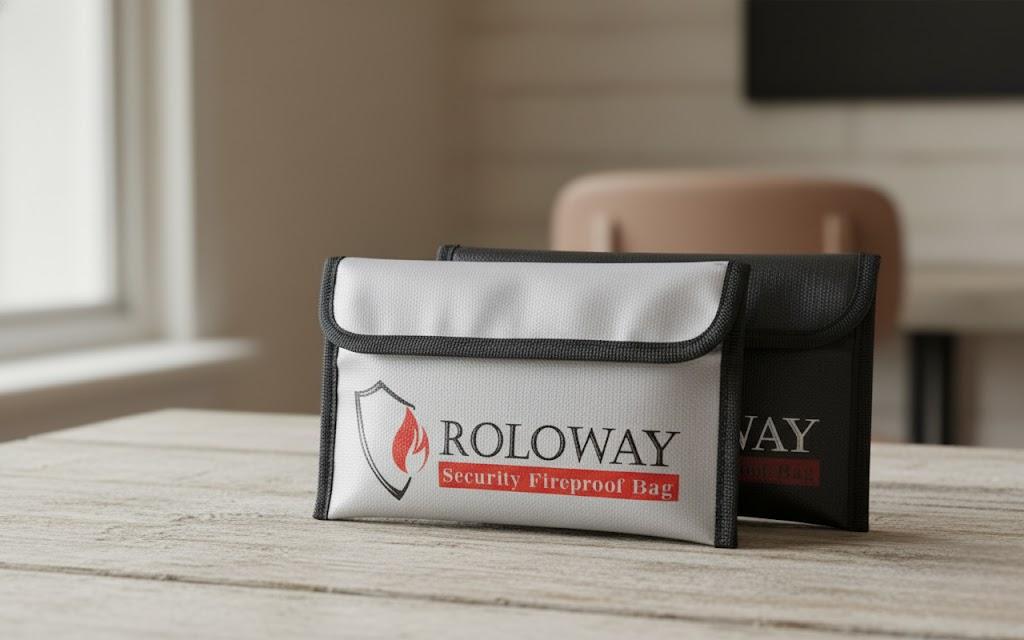The Short Answer: Yes, but with limitations.
A high-quality fireproof cash bag can successfully protect your money and valuables from damage during a typical house fire for a limited time. They are designed to withstand high temperatures for a specific duration, giving you a crucial window to retrieve them. However, they are not a substitute for a fireproof safe and offer the best protection when used as part of a larger fire safety plan.
1. How Does a Fireproof Cash Bag Work?
A fireproof cash bag works by using multiple layers of specialized, heat-resistant materials to insulate the contents from the extreme heat of a fire.
-
Outer Layer: This layer, often made of silicone-coated fiberglass, repels direct heat and flames. The silicone coating also adds a layer of water resistance, protecting against sprinklers or fire hoses.
-
Inner Layer(s): Interior layers, which may include materials like aluminized fiberglass or aluminum foil, reflect radiant heat and provide additional thermal insulation. This multi-layer construction slows down the transfer of heat to the inside of the bag.
-
The Goal: The primary function is to keep the internal temperature of the bag below the combustion point of paper (around 450°F or 232°C) for a rated period, thus protecting your cash and documents.
2. Key Features to Look For
When choosing a fireproof cash bag, consider these critical factors:
-
Temperature Rating: Look for bags rated to at least 1500-2000°F (815-1093°C), as a typical house fire can reach these temperatures.
-
Duration: The bag should specify how long it can withstand the rated temperature (e.g., 30 minutes, 1 hour). This is a critical factor for effectiveness.
-
Material Construction: Multi-layered, silicone-coated fiberglass is the industry standard for effective protection.
-
Closure System: A secure closure is vital. Look for a combination of a fire-resistant zipper and a strong velcro flap to prevent flames and heat from entering.
-
Water Resistance: Fire events often involve water. A water-resistant bag offers a second layer of defense for your valuables.
3. Material Comparison: What Are They Made Of?
Different materials offer varying levels of heat resistance. Here’s a quick comparison:
| Material | Temperature Resistance (Approx.) | Key Features |
| Silicone-Coated Fiberglass | Up to 2000°F (1093°C) | Durable, water-resistant, non-itchy feel. |
| Aluminized Fiberglass/Foil | Up to 1112°F (600°C) | Excellent at reflecting radiant heat. |
| Kevlar® | Up to 752°F (400°C) | High strength, self-extinguishing properties. |
| Silica | Up to 1800°F (982°C) | Excellent insulation, non-combustible. |
4. Understanding the Limitations
While effective, a fireproof cash bag is not indestructible. It's crucial to understand its limits.
-
They Are Fire-Resistant, Not Fire-Proof: No bag can withstand a fire indefinitely. They are rated for a specific time and temperature. A fire that burns longer or hotter than the bag's rating can still damage the contents.
-
They Are Not a Safe: A portable bag does not offer theft protection. It is also more susceptible to physical damage from falling debris during a fire compared to a heavy-duty fireproof safe.
-
Water Damage: While most are water-resistant, they are generally not fully waterproof if completely submerged for an extended period.
5. Best Practices for Maximum Protection
To get the most out of your fireproof cash bag, follow these simple steps:
-
Step 1: Don't Overfill: Tightly packing the bag can strain the seams and zipper, potentially creating weak points.
-
Step 2: Store in the Safest Location: Keep the bag on the lowest floor of your home, as heat and fire rise. An interior closet or a basement is often a good choice.
-
Step 3: Combine with a Fireproof Safe: For ultimate protection, place your fireproof cash bag inside a larger, UL-rated fireproof safe. This provides two robust layers of defense against fire, water, and theft.
Frequently Asked Questions (FAQ)
Q1: Will a fireproof cash bag protect against the water from a fire hose?
A: Most high-quality bags are water-resistant due to their silicone coating and can protect contents from sprinklers or brief exposure to a fire hose. However, they may not be fully waterproof if submerged.
Q2: What are UL and EN certifications for fireproof products?
A: Underwriters Laboratories (UL) and European Norm (EN) are independent bodies that test products for safety and performance. A certification like UL 72 means the product has passed rigorous testing to protect paper documents by keeping the internal temperature below a certain threshold (e.g., 350°F) for a specified time during a fire.
Q3: Can I store electronics or batteries in a fireproof cash bag?
A: It is generally not recommended to store lithium-ion batteries in a standard fireproof bag, as they can pose their own fire risk (thermal runaway). For items like hard drives or USB sticks, look for a bag with a data protection rating (e.g., UL 72 Class 125), which ensures the internal temperature stays low enough to prevent damage to sensitive electronics.
Q4: Is a fireproof bag better than a fireproof safe?
A: They serve different purposes. A bag offers portability (a "grab-and-go" solution) and a foundational layer of fire resistance. A safe offers longer-duration fire protection, higher security against theft, and greater structural integrity. The best solution is to use both.

